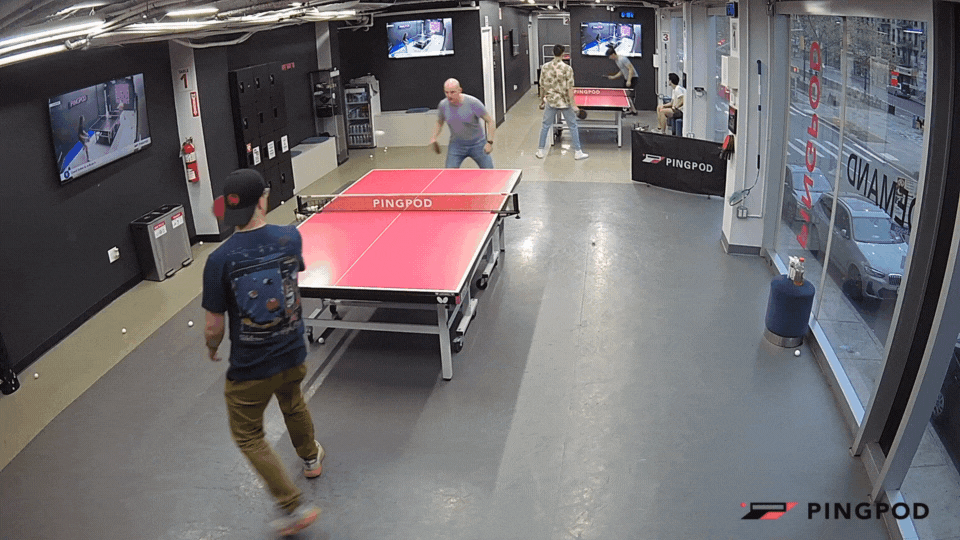PingPod: table tennis with a side of Big Brother
Let's see if it's worth playing ping pong in a panopticon

A quick smack of a paddle and the tiny plastic ball flew over the net and slammed down onto the table, too hard and too fast to be returned.
“There’s something I didn’t tell you,” my opponent growled, pausing for dramatic effect. “I had a ping pong table in my basement growing up.”
I smirked, and picked up the ball to serve. Another quick smack and a slam. Serve won.
“There’s something I didn’t tell you,” I spat back. “So did I.”
Ping pong—or table tennis, or “whiff-whaff” as Wikipedia insists some people call it—is a versatile sport. Thanks to being table-based, it can be played in a relatively small, indoors area year-round. It’s fun and casual, but it’s also an Olympic sport dominated by China ever since it joined the games in 1986 (Forest Gump’s game didn’t count for our record, unfortunately).
So it makes sense that, like its slightly larger cousin pickleball, VC-funded startups have come for ping pong. That’s how my opponent and friend Thomas Baldwin¹ and I ended up at PingPod, an “automated table tennis space, open 24/7” with locations across New York, New Jersey, Philadelphia, and soon, Boston and Miami.
We booked a 30-minute session at the Lower East Side location for $15. It would’ve been more if we booked the private room—on the ground floor of the building and fully on display to all passersby—but we stuck to the “open pod,” a sort of cross between a gym and a sterile co-working space. There were TVs on every wall advertising league nights and showing clips of fiery volleys, a few lockers, and a mini-fridge full of drinks for rehydration.
Conspicuously absent? Any employees. This is where the “automated” part comes in. After reserving a table, you can unlock the door to PingPod through their app a few minutes before play time. Once you get inside, you check in to your table using a touchscreen on the wall—which also tracks your score (thanks to buttons underneath the table which, unfortunately, you have to manually press, though I’m certain automated score-tracking is on the PingPod roadmap) and lets you record “replays.”

By default, when you hit the replay button, PingPod will save a recording of your last 30 seconds of play, hopefully catching that brilliant volley or forehand smash. They can save those clips because they are recording everything in the space at all times. Presumably, there’s someone watching those cameras, ready to note down any infractions and automatically charge you a fine. Most of the rules are pretty obvious—don’t break things, don’t kill anyone with a sick smash, don’t steal from the mini-fridge (you check out any purchases from the app, of course). Others may be disappointing—namely, no alcohol. While I understand PingPod not wanting to turn into BeerPongPod, the prohibition on alcohol definitely puts a damper on the private party rooms.
The space isn’t the only thing that’s automated—you can even automate your opponent (sorry Thomas, AI came for your job). Some of their locations have “robot tables,” a machine that spits balls back out at you at various angles, speeds, and spins so that you can practice specific techniques. If you prefer a human touch, you can hire a coach through PingPod, or find opponents through their community platform. PingPod also runs leagues and open matches, if you’re looking to take your game to the next level.
If you can get over the 1984 of it all, PingPod is a fun spot to play ping pong. There are a plethora of balls and even a fun little net to help you pick them up when you’re done. The screen makes it easy to keep track of the score and who’s serving, and your match results are synced over to the app along with your replays. And our location was surprisingly busy and lively, with large groups swapping turns behind the paddle. PingPod straddles that line between casual and serious players really well—you can pop in for a quick sesh before a night out, or test your Olympic aspirations with a coach or league night. Plus, if you’re a bit of a ping pong exhibitionist, you can get off on being watched.
At $15 per half hour—even more expensive at peak times or in private rooms—your PingPod bill can really add up. Replays are also weirdly expensive, considering they’re already recording you—I got five for free, but after that it was fifty cents for a thirty-second clip. If you’re serious about ping pong, you can get a membership ranging from $60 to $120 per month, depending on how many locations you want access to, and even then, you’ll still have to pay for reservations during peak hours.
PingPod isn’t your only option for ping pong in the city. SPiN, Susan Sarandon’s ping pong social club franchise, has a full restaurant and bar to go along with your ping pong, but it’s more expensive at $49–59 per hour. You can also find tables in various other bars, though there’s a good chance they’re being used for beer pong. If you can stand fresh air, there are outdoor ping pong tables in public parks across the city—just bring your own paddle and balls. Of course, you’ll miss out on one of ping pong’s biggest advantages: all-weather playability.
But if you’re just looking for a quick fix of ping pong and don’t have a conveniently accessible basement, you could do worse than PingPod. Just don’t commit any whiff-whaff thoughtcrimes.
Of judging books by their covers fame. ↩




